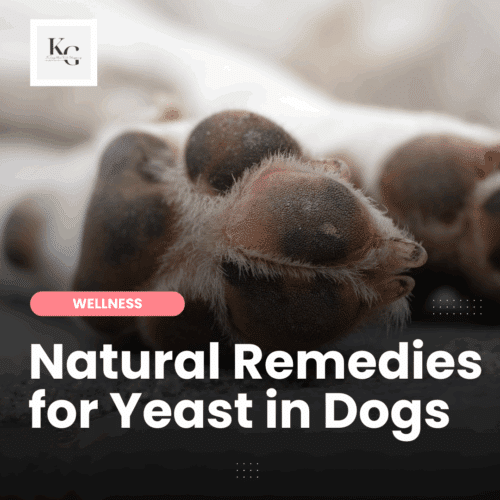Keep the Tail Wagging is supported by pet parents. I occasionally earn a commission (at no additional cost to you) when you click through an affiliate link to one of my favorite products. Thank you for your support. Read More
Have you heard of Seresto collars? They're flea and tick collars for dogs and sound like the perfect alternatives to the chemicals we put on our dogs. I was interested when I first learned about them but didn't bother looking further because my dogs didn't wear collars. It turns out that this was a good thing because reports are now showing that Seresto flea and tick collars have been linked to over 75,000 injuries and nearly 1,700 pet deaths. There have even been injuries to humans linked to these collars. Update: in 2024, the makers of Seresto collars settled a class action lawsuit, awarding 75 million dollars to victims.
This is a big world, and I'm certain plenty of pets will do fine with these collars. This post is for people who either have had a negative experience with these collars or have read about them and would prefer not to risk injuries (or death) with their pets.
So, what's the alternative?
In this post, I'm going to share 5 natural alternatives to Seresto flea and tick collars, providing the pros and cons of each. Please note that every dog is different and I can only speak to my experience with my dogs, living in Western Washington.
Why We Need to Protect Our Dogs from Fleas and Ticks
Other than the discomfort flea bites cause, there is a risk of illness with fleas and ticks. I learned about flea allergies when I started blogging and was shocked – dogs can be allergic to fleas? Well, kind of – they're allergic to the flea saliva. Plus fleas can transmit disease from animal to animal – they need to bite an infected animal. That's something that helped spread the plague – fleas biting infected rats and then biting humans. Bastards!!!
And then there are ticks. They freak me out because of the long list of diseases ticks can transmit to our dogs:
- Lyme Disease
- Anaplasmosis
- Babesiosis
- Ehrlichiosis
- Powassan Virus Disease
- Borrelia miyamotoi Disease
- Borrelia mayonii Disease
- Rocky Mountain Spotted Fever (RMSF)
So, I get that it's important to protect our dogs, and the idea of reaching for a collar makes this step in raising dogs so much easier. But is it safer? And is it natural?
Why I Don't Like Seresto Flea and Tick Collars
I don't put collars on my dogs (except Apollo, who loves his collars), and I'm not a fan of Seresto flea and tick collars because I don't like putting any chemicals against my dogs' skin or close to their brains. Plus, check out the injuries people are reporting.
- allergic reaction at the site where the collar sits on the dog; I've seen pics of dogs with raw skin and it looks painful.
- seizures in dogs and humans; we are at risk because we pet, hug, and sleep with our dogs.
- death; there have been nearly 1,700 deaths to date, and the EPA has yet to respond, and veterinarians are calling for calm.
There are so many natural options that have worked with my dogs that I don't have to accept the risk of using Seresto collars; even if some believe the risk is small. And if you're not convinced that Seresto collars may be dangerous, check out this post from holistic veterinarian Dr. Laurie Coger: Why I Don't Recommend Seresto Collars
If you like to share your experience with Seresto, visit Regulations.gov to share your story.
5 Natural Alternatives to Seresto Flea and Tick Collars
The following are five alternatives to Seresto flea and tick collars. We've had success with all of the following, and I would like to use a few of these in rotation because I worry about bugs becoming immune to my methods. Stupid smart bugs!
So here goes…
1 – Essential Oils
I love essential oils. I have created a large collection of oils from animalEO, Plant Therapy, and Simply Earth. Dr. Melissa Shelton, founder of animalEO, has formulated amazing blends that are safe for pets and I alternate the following to repel fleas and ticks:
As I stated above, I prefer to alternate products because I believe that using one product over an extended period can make it less effective. Plus, every dog is unique, so what works for one dog may not work for another – therefore, I alternate.
What I love about animalEO is that I can put these on my dogs without fear of causing injury. The “RTU” means ready to use; I can use these directly from the bottle or dilute them further if the scent is still too strong for one of my dogs. So far, I haven't had to do this with these oils.
Although tempting, I do not recommend buying random oils from other brands and using them instead of animalEO. While I was a skeptic for a long time, I've been using these oils for over six months and have not been disappointed. (Thanks again for the friendly reminders, Diane).
Before you tell me that essential oils are dangerous for pets, please take a moment to visit Dr. Shelton's website to learn more. She also has a valuable desk reference guide for using her oils with pets.
2 – Kin+Kind Flea & Tick Dog and Cat Spray
I started using Kin+Kind Flea and Tick Spray in 2020 after trying to figure out if Wondercide was still effective on my dogs. They changed an ingredient after losing sourcing and the social media world had a mild meltdown. Usually, I roll my eyes at these things, but this time around, I paid attention. The news of Wondercide's change inspired me to check out other products, and this is when I started using Kin+Kind products.
It works great for my dogs.
3 – CocoTherapy Coconut Oil
I love coconut oil for many reasons and use it daily in our home both for health and beauty. It's a great product to have on hand because it has so many benefits, including serving as a flea repellent. I massage coconut oil into my dogs' coats between baths to freshen their coat and make them less attractive to bugs.
When we apply coconut oil to the coat, our dogs' hairs act like a candle wick, allowing the coconut oil to move down the hair shaft and to the skin, spreading around the body as our dogs move. Coconut oil repels fleas and ticks on contact. When coconut oil is on the skin and coat, it coats the exoskeleton of fleas, ticks, and any other annoying bug, suffocating them and making it hard for them to move. Plus, since coconut oil has antibacterial, antimicrobial, and anti-inflammatory properties, it helps to prevent bug bites from becoming infected.
4 – Cedarcide Topical Flea & Tick Spray
If you or your dog are sensitive to cedar, this may not be the right product for you. However, if allergies aren't a concern, add Cedarcide to your list of natural alternatives.
Cedarcide is chemical-free; it uses plants to kill and repel bugs that bite (fleas, ticks, mosquitoes, bed bugs, mites, and chiggers). I don't even know what chiggers are, but they sound gross and creepy. Cedarcide works on contact; I simply spray my dogs with a light mist, massage the product into their coat, and we're good to go. The brand boasts a 99% kill rate for fleas. The product not only kills bugs on our dog, it repels bugs as well.
I've used Cedarcide for years, alternating it with Wondercide, and it's consistently worked for us.
5 – Wondercide Topical & Indoor Flea & Tick Spray
Wondercide is an old favorite that I've strayed away from over the past year when I was introduced to other options. While I don't currently use it, I don't mind having it in the rotation with my dogs.
A few years ago, people freaked out because Wondercide changed an ingredient in its formula. Someone even tried to sue them for the change, claiming that their products were no longer “natural.” The lawsuit was either canceled or tossed out, and while it inspired my search for more natural flea and tick repellents, the lawsuit didn't turn me off of this brand.
Wondercide uses essential oils to repel fleas, ticks, and mosquitoes. What I like about Wondercide is that they offer several scents – so if you or your dog is allergic to cedar, there are other options:
Build an Anti-Flea Flower Garden
While you're stocking up on natural flea and tick repellents, consider building a flower garden with plants that repels fleas and ticks, too. The following are plants that are easy to grow, and also repel fleas, ticks, and mosquitoes – Oh My!
- rosemary
- sage
- basil
- thyme
- marigolds
- chrysanthemums
- chives
- lemongrass
- lavender
Before you choose your plants, make sure there are no risks to your dogs. For instance, rosemary extract/oil can trigger seizures in some dogs. The rosemary plant doesn't bring the same risk. My dogs don't have any sensitivities to the above plants and don't eat my plants/flowers, so I feel comfortable adding a few of these to my yard. You know your dog best, so choose plants that fit your dog well.
Because fleas like shaded areas, I've decided to plant rosemary and thyme in the dogs' yard's shaded areas. I love gardening—kind of.
What About Garlic?
First of all, nooooo, garlic IS NOT toxic to dogs. So many people are spreading this myth thanks to a misleading study, and I wish it would end. I even see vets and vet techs warning people about garlic when it has so many benefits.
The benefits of garlic for dogs include:
- natural and safe flea and tick repellent – bugs don't like the taste of garlic
- boosts the immune system
- fights cancer cells
- boosts liver health and rids the body of toxins
- fights infections (bacterial, viral, fungal)
- fights parasites
- lowers cholesterol
- boosts the metabolism
Garlic should not be fed to puppies, pregnant dogs, or dogs with anemia or hemangiosarcoma.
If you're interested in trying out fresh garlic (never use the jarred minced garlic), the dosage, per Dr. Pitcairn (The Complete Guide to Natural Health for Dogs and Cats) is as follows:
| Pounds | Kilograms | Amount of Garlic |
| 10-15 lbs | 4.5-6.8 kg | 1/2 clove |
| 20-40 lbs | 9.1-18.1 kg | 1 clove |
| 45-70 lbs | 20.4-31.8 kg | 2 cloves |
| 75-90 lbs | 34.0-40.8 kg | 2-1/2 cloves |
| 100 lbs and more | 45.5 kg and more | 3 cloves |
I don't use fresh garlic to repel fleas and ticks because it needs to be smushed up, sit for 20 minutes, and then fed to the dogs. I already have a pretty involved feeding routine, I don't want to add another step. So, I purchased Springtime Bug Off Garlic Granules for Dogs last year as another option. Following the recommended dosage on the container, I don't worry about reaching toxic levels with my dogs.
I've used enough garlic granules to confirm their effectiveness.
What About Diatomaceous Earth?
For years, I've heard about the wonders of food-grade diatomaceous earth (DE) – it's the flea killer we can eat!!! But is DE all that it's cracked up to be? I don't know if it works or not. I've heard from some who swear by DE, while others have not seen the benefits.
Diatomaceous earth is comprised of the fossilized remains of teeny sea creatures (don't come for me; I don't feel like looking this up). It works by drying out the exoskeleton of fleas and ticks, killing them. That sounds great, right? Just sprinkle it on our dogs' coats, and they'll be flea/tick-free! The downside to DE is that we and our dogs can breathe it in during application, which isn't good for us.
With so many other products on the market that I know work, I decided to leave diatomaceous earth on the store shelves.
Spring is days away, and those spring flowers are accompanied by bugs. Lots of biting, annoying bugs. The products I mentioned above protect my dogs against fleas, ticks, and mosquitoes, allowing us to enjoy our property and the warmer weather.
I hope this helps.






